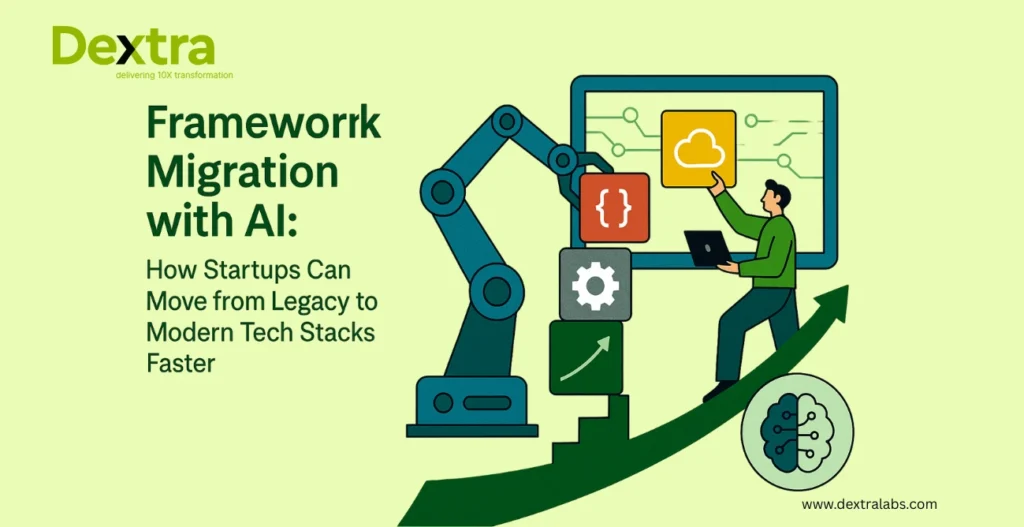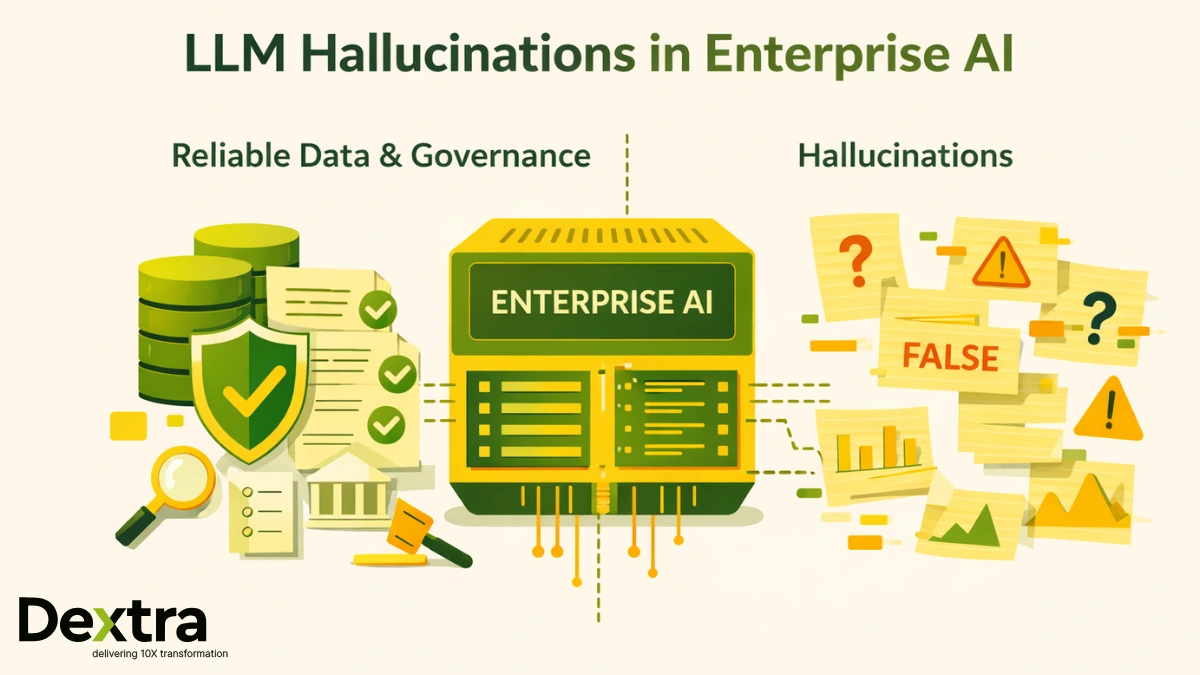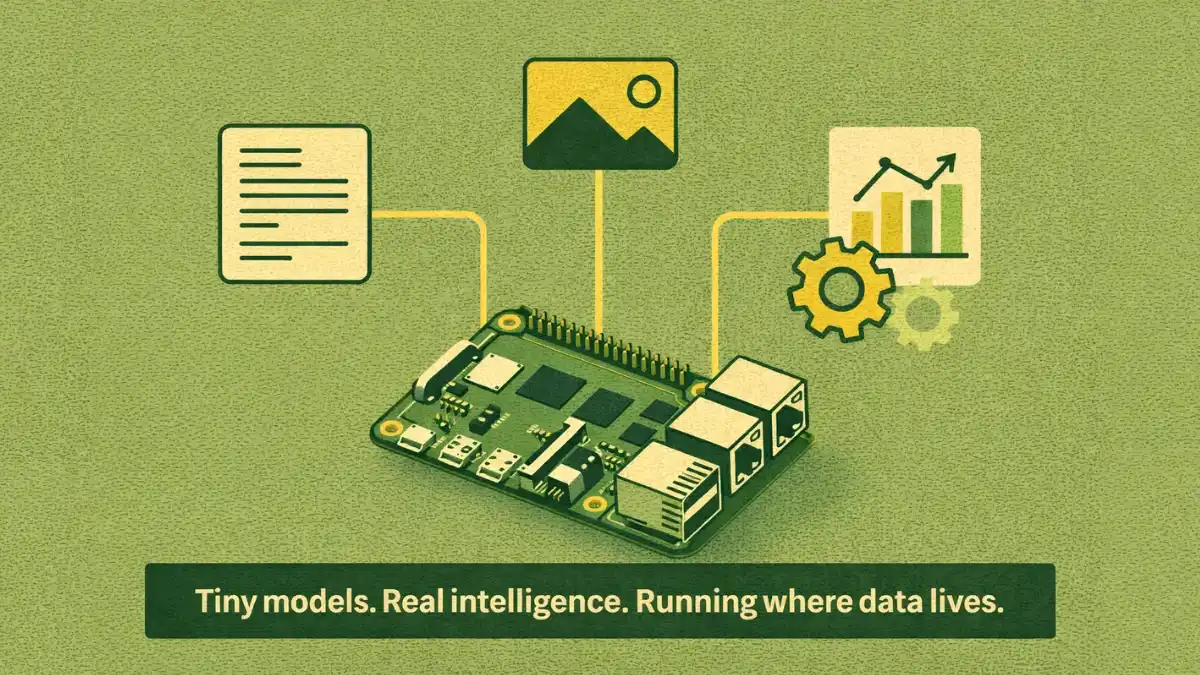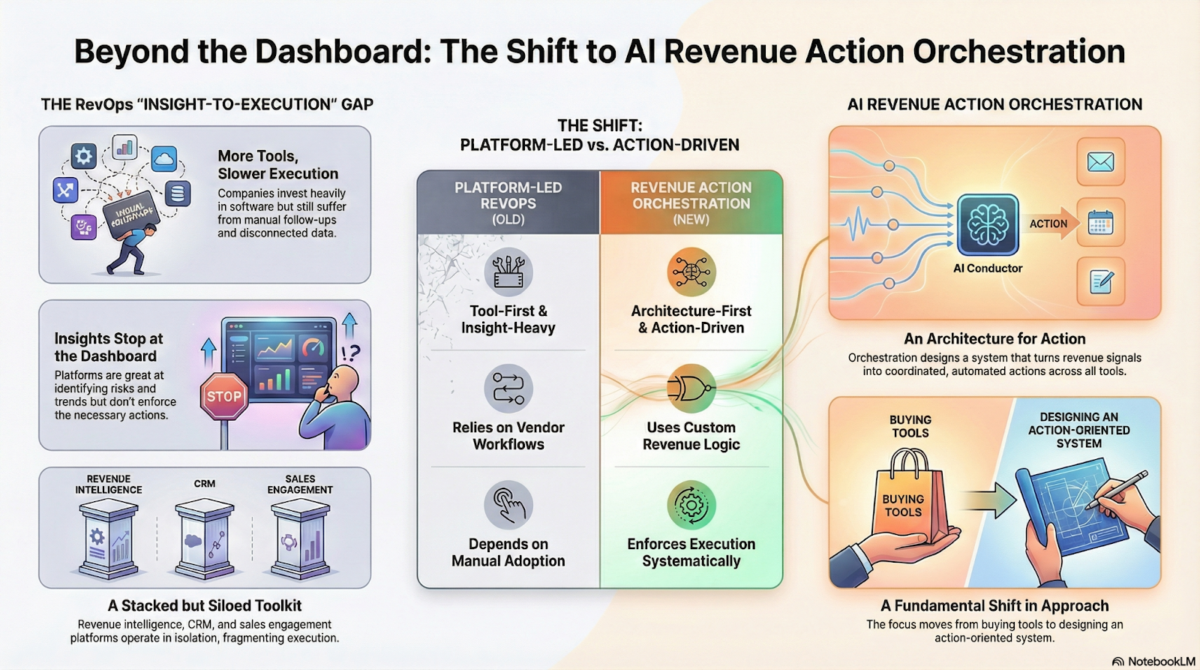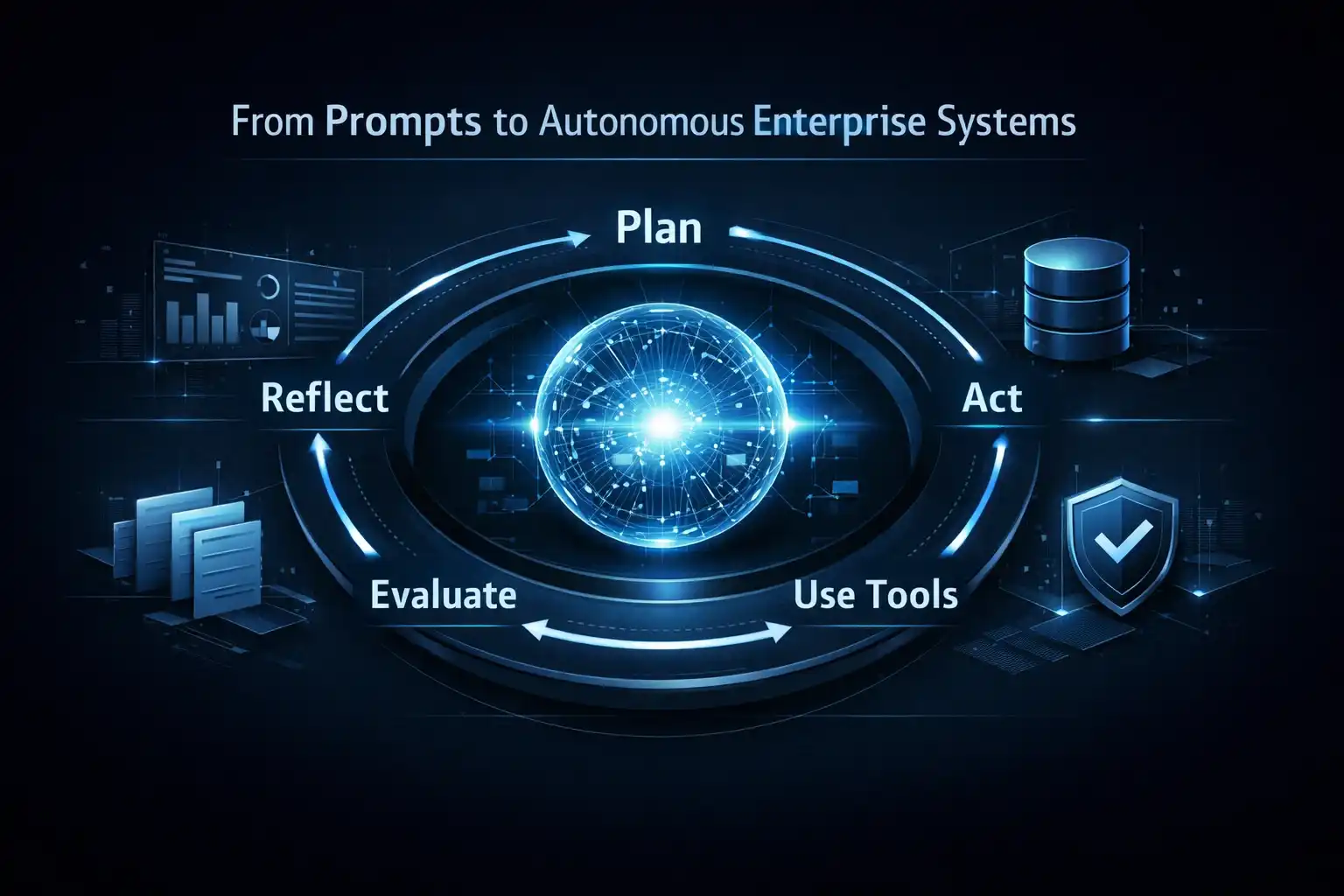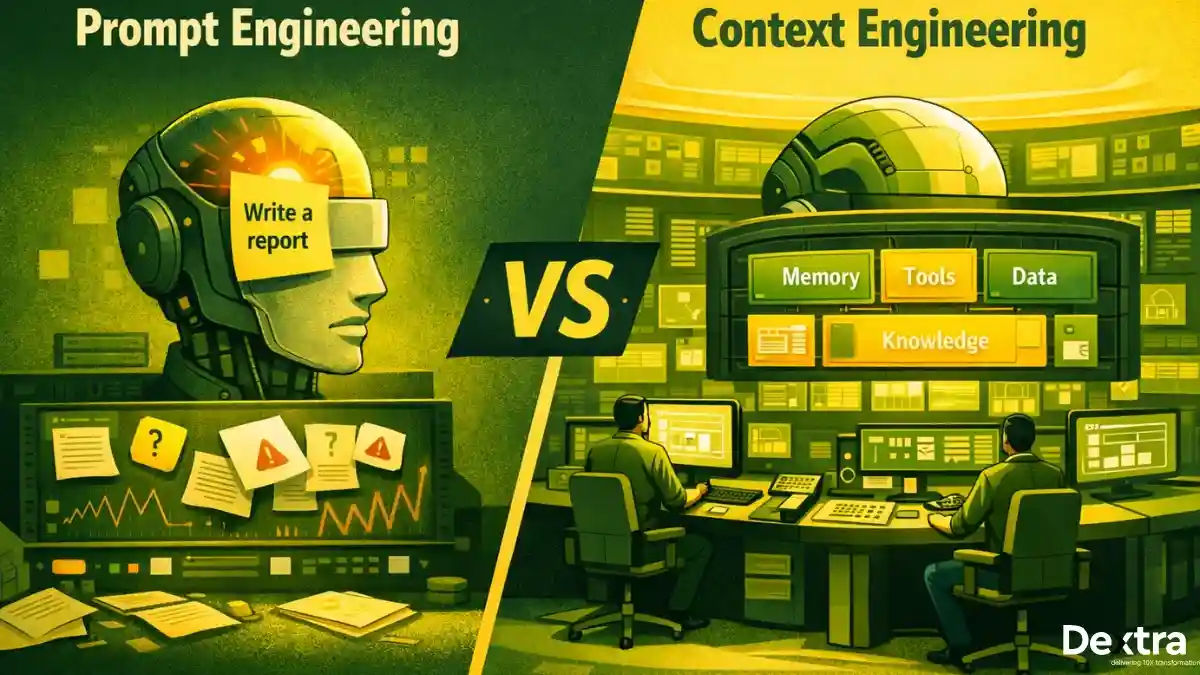70% of global IT spending still goes toward maintaining legacy systems—AI is flipping this trend. Are you also looking for AI consultancy for legacy code migration?
For most startups, legacy systems, such as those developed using Java, PHP, or .NET, are holding them back. Although these legacy systems were sufficient in the past, they now hinder progress. They complicate innovation, the integration of new technologies, and scaling as your business expands.
But here’s the good news: AI for framework migration can help you in migrating from these legacy systems to newer ones such as Node.js, Python, or Go – quicker and more efficiently. AI enabled Code migration tools are meant to automate the process of migration, saving time and cost, and making the process safer.
We at Dextralabs focus on applying AI to help such startups as yours in upgrading their technology stacks. We will take you through legacy code modernization, and you can move to a more flexible, scalable, and cost-saving system with the least disruption.
In this article, we will guide you through how AI-driven migration can help you fix your technology issues, why now is the best time to migrate, and how Dextra Labs will help you!
Challenges of Traditional Framework Migration
1. Time-Consuming Manual Rewrite: Migration of legacy code involves rewriting it manually, which is time-consuming.
2. High Error Rates and Hidden Bugs: Manual rewrites are prone to errors and bugs that might not appear until later, resulting in unforeseen issues.
3. Downtime during Transition: The transition process typically involves shutting down or slowing down the system, which may interfere with services and damage the user experience.
4. Lack of Skilled Developers for Both Stacks: It is challenging to find skilled developers who are good in both outdated and new technologies, which may hold back the transition process.
5. Uncertainty about Performance after Migration: After the code migration, it’s difficult to predict if the new system will work as desired, resulting in future problems after launch.
Also Read: AI-Driven Tech Productivity for Startups in USA, UAE & Singapore
How AI Solves Framework Migration Challenges?
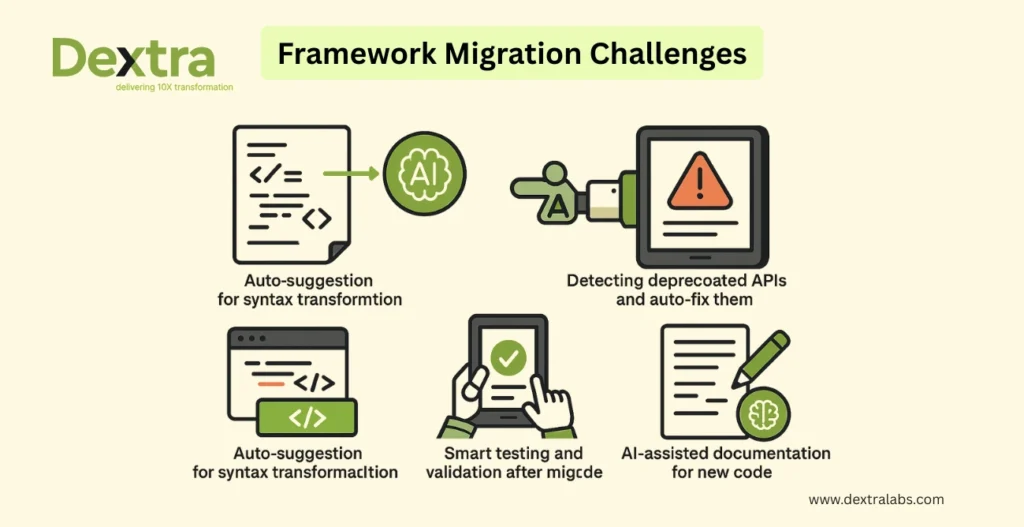
1. Code Understanding & Mapping Across Languages
AI can scan legacy code and map it directly to contemporary languages, improving migration speed and ease.
2. Auto-Suggestion for Syntax Transformation
AI tools provide correct syntax recommendations while changing legacy code to new languages, reducing manual effort and errors.
3. Detecting Deprecated APIs and Auto-Fixing Them
AI detects outdated APIs in the legacy system and auto-replaces them with the correct, new ones, which saves time and results in fewer errors.
4. Smart Testing and Validation After Migration
AI runs automated tests to check the new system’s performance, ensuring everything works correctly and reducing bugs.
5. AI-Assisted Documentation for New Code
AI can generate clear, detailed documentation for the new code, making it easy for your team to comprehend and support
Common Use Cases We Handle
Java to Node.js / Python / Go
Moving from Java to Node.js, Python, or Go is a common migration. AI for framework migration helps automate the process, ensuring faster and more accurate code transformation.
PHP to Python/Django or MERN Stack
Migrating PHP to Python/Django or MERN stack (MongoDB, Express, React, Node.js) is often needed to modernize applications. AI tools simplify the legacy code modernization process by automatically refactoring PHP code and mapping it to the new tech stack.
.NET to Modern Microservices
Transitioning from .NET to modern microservices architecture is a smart way to scale and improve performance. AI-powered solutions assist in AI code migration, helping break down monolithic .NET applications into independent microservices.
Monolith to Microservices with AI Mapping Tools
Monolith to microservices migration can get complex, but AI mapping tools simplify it by mapping out dependencies and splitting your code automatically into manageable, scalable microservices.
Also Read: How AI Taking Over Farms and Clinics?
Dextralabs Migration Framework (AI-Led Consultancy)
Here are the important Steps for Framework Migration with DextraLabs’ AI-Led Consultancy:
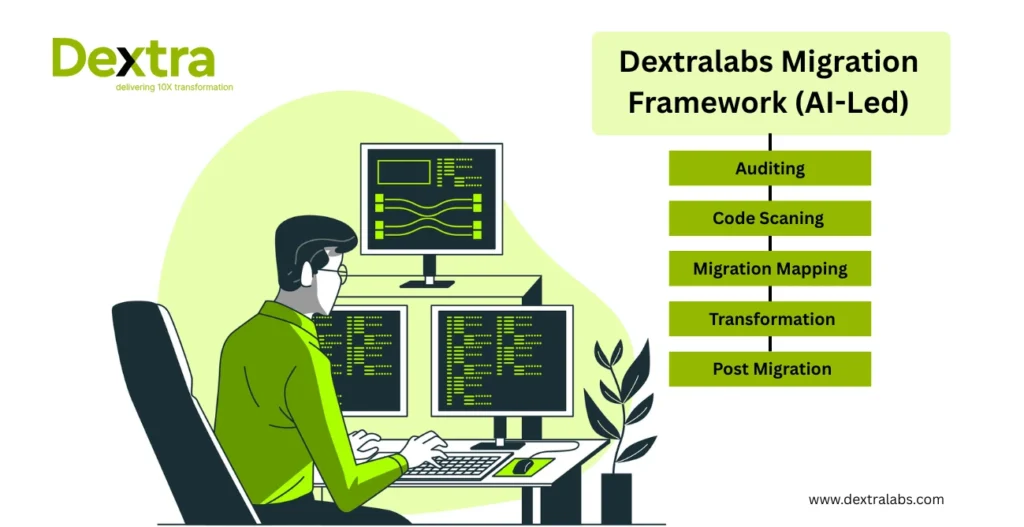
Step: 1. Audit Current Architecture
We start by carefully examining your current system to find out the way it functions and where it can be improved. This helps in effectively planning the migration process.
Step: 2. AI-Enabled Code Scanning and Complexity Analysis
Using AI, we scan the legacy code for complexity, dependencies, and areas of potential issues. This step helps us identify the parts that need the most attention, for an easier code migration.
Step: 3. Migration Mapping (Function-by-Function)
AI helps us in mapping your existing code to its new equivalent function by function. This ensures all aspects of your app are converted correctly and operate in the new framework.
Step: 4. AI-Assisted Transformation and Testing
With AI, we automate the transformation of your old code to the new system. AI tools also execute tests to make sure that everything is correct during the migration, reducing the chances of bugs or errors.
Step: 5. Post-Migration Performance Tuning
After migration, we use AI to keep an eye on and improve the performance of your new environment. This means it runs well and manages traffic efficiently.
In-House + AI = Best of Both Worlds
While AI takes care of most of the migration, our in-house team works in conjunction with the tools to make sure everything is to your business requirements. The combination of AI and human expertise delivers the best results.
Minimal Downtime, High Accuracy
Our AI-driven approach ensures that your migration happens with minimal downtime. This translates to less downtime on your operations while preserving high accuracy on the migration process.
Case Studies from the USA, UAE, and Singapore:
Airbnb’s AI-Driven Test Migration – From 18 Months to 6 Weeks
In a landmark example of AI-assisted software modernization, Airbnb successfully migrated approximately 3,500 React component test files from Enzyme to React Testing Library (RTL) in just six weeks—a process initially estimated to take 18 months manually.
The company developed a scalable, LLM-driven pipeline that automated validation and refactoring steps. Each file progressed through a state machine, with AI interventions triggered upon validation failures. This approach enabled the migration of 75% of target files within four hours. To enhance accuracy, Airbnb expanded prompt contexts to include up to 100,000 tokens, incorporating related files and few-shot examples. A retry mechanism dynamically updated prompts based on errors and file versions.
For the remaining 900 files that didn’t meet validation criteria, Airbnb implemented tools for targeted re-runs and tracked progress through migration status comments. After four days of iterative refinement, they achieved a 97% completion rate, manually addressing the final 100 files.
This case underscores the potential of AI in accelerating framework migrations, offering startups a blueprint for leveraging LLMs to modernize tech stacks efficiently.
USA EdTech
A leading EdTech company in the USA faced challenges with its large Java monolith, making it difficult to scale and update. Using AI for framework migration, we helped refactor the legacy code and migrate it to a Node.js microservices architecture. This move resulted in a 40% reduction in development time, enabling the team to roll out new features faster and improve scalability.
UAE Retail SaaS
A retail SaaS provider in the UAE struggled with a slow, outdated PHP application. By using AI-driven migration tools, we changed their system into a modern stack with React for the frontend and Python for the backend. The result was a 3x boost in performance, improving the overall user experience and customer engagement.
Singapore Logistics Platform
One of the logistics platforms in Singapore was based on an outdated .NET system that was inflexible and had poor performance. With the help of AI code transformation and auto-testing techniques, we migrated their setup successfully to Golang, increasing performance substantially. The new system could handle more data with lower overhead, and that made it more efficient.
Is Your Startup Ready for Framework Migration?
- Is your legacy stack slowing development?
- Do you face hiring challenges for your current framework?
- Want to move to a scalable, cloud-native architecture?
If you said “yes” to any of these questions →
It’s time for an AI-led migration! Dextralabs can help you migrate smoothly and efficiently, saving your time, money, and resources.
Get a Free Tech Stack Audit with Dextralabs
We provide a free 30-minute migration audit to get you familiar with your existing tech stack and discuss how AI can help your migration process and make it quicker.
Take the first step towards upgrading your stack today – reach out to us for your free audit!
If you’re a startup looking to accelerate framework migration and future-proof your tech stack, leveraging AI isn’t just an option—it’s a competitive edge. Our AI consulting services are designed to help companies like yours streamline the transition from legacy systems to modern, scalable architectures with minimal downtime and maximum impact. From strategy to implementation, we guide you every step of the way. Explore our AI consulting solutions to see how we can support your transformation journey.
Frequently Asked Questions (FAQs):
Q. Can AI really migrate an application framework?
Yes, AI can automate most of the migration process, converting legacy code to modern frameworks rapidly and with precision, saving manual labor and errors.
Q. How long does it take to migrate from Java to Node.js using AI?
Migration time depends on the size of the project, but AI can noticeably accelerate the process, usually decreasing migration time by 30-40% compared to manual efforts.
Q. Will performance be affected during migration?
With AI-led migration, downtime is minimized, and performance testing is done in parallel, resulting in smooth operations and minimal impact on performance.
Q. What’s the cost advantage of AI-led migration vs traditional?
AI-led migration reduces the necessity of extensive manual testing and coding, saving time as well as development costs, hence being more economical compared to traditional migration.

